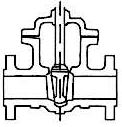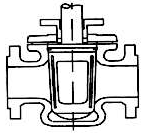This set of Pulp and Paper Multiple Choice Questions and Answers (MCQs) focuses on “Valves”.
1. What is the value of C ?
Q = CA (PΔ)1/2
a) Hydraulic valve coefficient
b) Constant for flow conditions
c) Boltzmann constant
d) Kraft’s constant
View Answer
Explanation: At a given instant in time the conditions at every point are the same, but would change with time. An example is a pipe of constant diameter connected to a pump pumping at a constant rate which is later switched off.
2. What is this hydraulic valve coefficient value for?
Cv= Q (G/ΔP)1/2
a) Solid
b) Liquid
c) Steam
d) Gas
View Answer
Explanation: The flow capacity of a valve for liquid is calculated by the hydraulic valve coefficient Q, the flow of water through a wide—open valve in U.S. gal/min for a pressure gradient of 1 psi. For a given nominal valve size the highest Q is achieved with ball valves followed by gate, plug, and globe valves.
3. What is this hydraulic valve coefficient value for?
Cv= Q / 1360 (TfG / ΔP P2)1/2
a) Solid
b) Liquid
c) Steam
d) Gas
View Answer
Explanation: The flow capacity of a valve for gas is calculated by the hydraulic valve coefficient Q, the flow of water through a wide—open valve in U.S. gal/min for a pressure gradient of 1 psi. For a given nominal valve size the highest Q is achieved with ball valves followed by gate, plug, and globe valves.
4. What is this hydraulic valve coefficient value for?
Cv= W / 63.3 (v / ΔP)1/2
a) Solid
b) Liquid
c) Steam
d) Gas
View Answer
Explanation: The flow capacity of a valve for steam is calculated by the hydraulic valve coefficient Q, the flow of water through a wide open valve in U.S. gal/min for a pressure gradient of 1 psi. For a given nominal valve size the highest Q is achieved with ball valves followed by gate, plug, and globe valves.
5. What is this hydraulic valve coefficient value for?
Cv= W / 63.3 (v / ΔP)1/2
a) Solid
b) Liquid
c) Steam
d) Gas
View Answer
Explanation: The flow capacity of a valve for liquids is calculated by the hydraulic valve coefficient Q, the flow of water through a wide open valve in U.S. gal/min for a pressure gradient of 1 psi. For a given nominal valve size the highest Q is achieved with ball valves followed by gate, plug, and globe valves.
6. What is the type of the valve?

a) Plug
b) Gate
c) Globe
d) Throttle
View Answer
Explanation: This valve also called as a sluice valve, is a valve which opens by lifting a round or rectangular gate/wedge out of the path of the fluid. The key feature of this valve is the sealing surfaces b/w the gate and seats are planar, so gate valves are often utilised when a straight-line flow of fluid and minimum restriction is desired.
7. What is the type of the valve?

a) Plug
b) Gate
c) Globe
d) Throttle
View Answer
Explanation: Plug valves are valves with cylindrical or conically tapered “plugs” which could be rotated inside the valve body to control flow through the valve. The plugs in plug valves have 1 or more hollow passage ways going sideways through the plug, so that fluid could flow through the plug when the valve is open.
8. What is the type of the valve?

a) Plug
b) Gate
c) Globe
d) Throttle
View Answer
Explanation: A globe valve, different from ball valve, is a type of valve utilised for regulating flow in a pipeline, consisting of a movable disk-type element and a stationary ring seat in a generally spherical body.
9. __________ valves utilise a flexible diaphragm (disk) against a fixed seat. Both of these allow the control mechanism to be completely sealed from the fluid without the utilization of seals or glands, although they are limited to relatively low temperatures and pressures.
a) Globe
b) Gate
c) Throttling
d) Diaphragm
View Answer
Explanation: Diaphragm valves (or membrane valves) consists of a valve body with two or more ports, a diaphragm, and a “weir or saddle” or seat upon which the diaphragm closes the valve. The valve is constructed from either plastic or metal.
10. The flow capacity of a valve is calculated by the _________ Cv, the flow of water through a wide—open valve in U.S. gal/min for a pressure gradient of 1 psi. For a given nominal valve size the highest Cv is achieved with ball valves followed by (in decreasing order) gate, plug, and globe valves.
a) Hydraulic valve coefficient
b) Constant for flow conditions
c) Boltzmann constant
d) Kraft’s constant
View Answer
Explanation: The flow of water through a wide—open valve in U.S. gal/min for a pressure gradient of 1 psi. For a given nominal valve size the highest Q is achieved with ball valves followed by (in decreasing order) gate, plug, and globe valves.
Sanfoundry Global Education & Learning Series – Pulp and Paper.
To practice all areas of Pulp and Paper, here is complete set of 1000+ Multiple Choice Questions and Answers.
If you find a mistake in question / option / answer, kindly take a screenshot and email to [email protected]
- Apply for Chemical Engineering Internship
- Check Chemical Engineering Books
- Practice Chemical Engineering MCQs
